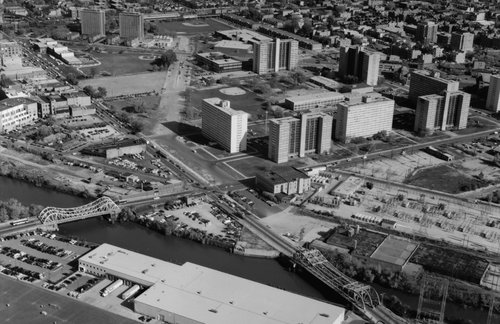
The northern portion of the Cabrini-Green housing project, which has since been demolished. About half of the Cabrini row houses, which sit just to the right of the frame of this image, are still occupied.
Cook County is home to two of the census tracts in the top 10 nationally for their share of growth in households making $200,000 a year or more since 2000, including the single fastest-growing cluster of such households in the entire country.
The top spot for growth in high-earning households may have been tough to fathom a couple decades ago, but to those who’ve watched development and demographic shifts in the area over the past 20 years, it might not be so shocking.
A census tract on the Near North Side that includes a swathe of the former Cabrini-Green housing project went from zero to 39 percent of all households at least doubling the six-figure threshold since 2000.
The 7th fastest-growing concentration of $200,000-a-year-and-up households is in Glenview, in an area called The Glen. It’s a roughly 1,100-acre chunk of the northern suburb that was once owned by the the U.S. Navy and was operated as a base until the mid-1990’s.
The data, compiled by the consulting firm Webster Pacific, function as a kind of yardstick for showing the most rapidly-gentrifying tracts of land in the country.
While it is noteworthy that two Chicagoland census tracts ranked highly on the list, it’s worth pointing out that these are not neighborhoods that have undergone change in a traditional, organic way, with amenities and new development gradually attracting wealthier demographics. The expanse of land that’s now The Glen had no non-military residents until its redevelopment, which started in the late 1990’s. It’s flanked by prosperous suburbs like Northbrook (which had a median household income of about $120,000 in 2017, according U.S. Census Bureau numbers), and the rest of Glenview (which had a median household income of about $104,000 in 2017, per the Census).
And while the Near North Side wasn’t built on formerly nonresidential land like The Glen, it has changed almost as dramatically, and has little remaining of its former low-income population. There were 654 public housing units in the neighborhood in 2017, according to an analysis by the Chicago Sun-Times. That’s a 62 percent drop from the number of such units neighborhood-wide in 2000, and an 82 percent drop from the 3,607 that Cabrini Green had at it peak. The 60610 ZIP code, of which the former housing project was a part, had a median household income of about $82,000 in 2017 according to the Census—well above the roughly $52,ooo citywide median at the time.